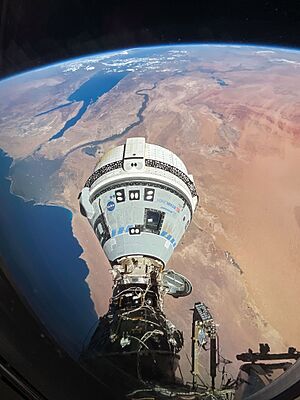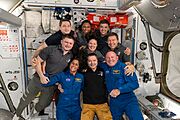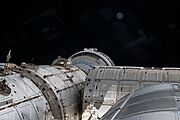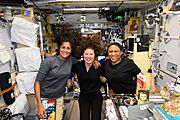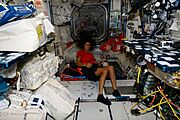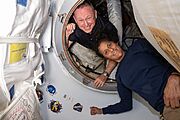Boeing Crew Flight Test facts for kids

Boeing Starliner Spacecraft 3 Calypso launches on the Crew Flight Test atop an Atlas V rocket
|
|
| Names | Boe-CFT |
|---|---|
| Mission type | Flight test |
| Operator | Boeing Defense, Space & Security |
| Mission duration | Planned: 8 days Capsule Final: 93 days, 13 hours, 9 minutes Crew: 329 days, 8 hours, 51 minutes |
| Spacecraft properties | |
| Spacecraft | Boeing Starliner Spacecraft 3 Calypso |
| Spacecraft type | Boeing Starliner |
| Manufacturer | Boeing Defense, Space & Security |
| Crew | |
| Crew size | 2 |
| Launching |
|
| Landing | None |
| Start of mission | |
| Launch date | 5 June 2024, 14:52:15 UTC (10:52:15 am EDT) |
| Rocket | Atlas V N22 (AV-085) |
| Launch site | Cape Canaveral, SLC‑41 |
| Contractor | United Launch Alliance |
| End of mission | |
| Landing date | 7 September 2024, 04:01:35 UTC (12:01:35 am MDT) |
| Landing site | White Sands Missile Range |
| Orbital parameters | |
| Reference system | Geocentric orbit |
| Regime | Low Earth orbit |
| Inclination | 51.66° |
| Docking with ISS | |
| Docking port | Harmony forward |
| Docking date | 6 June 2024, 17:34 UTC |
| Undocking date | 6 September 2024, 22:04 UTC |
| Time docked | 92 days, 4 hours, 30 minutes |
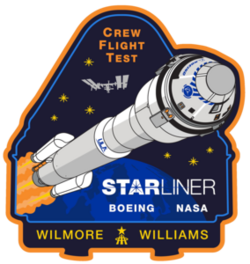 Boeing Crew Flight Test mission patch  Williams (left) and Wilmore (right) Commercial Crew Development
|
|
Boeing Crew Flight Test (Boe-CFT) was the first crewed mission of the Boeing Starliner capsule. Launched on 5 June 2024, the mission flew a crew of two NASA astronauts, Barry E. Wilmore and Sunita Williams, from Cape Canaveral Space Force Station to the International Space Station. The mission was meant to last eight days, ending on 14 June with a landing in the American Southwest. However, the capsule's thrusters malfunctioned as Starliner docked with the ISS. After more than two months of investigation, NASA decided it was too risky to return Wilmore and Williams to Earth aboard Starliner. Instead, the Boeing spacecraft returned uncrewed on 7 September 2024, and the astronauts will ride down on the SpaceX Crew-9 spacecraft in February 2025.
Originally scheduled for launch in 2017, Boe-CFT experienced numerous delays. The spacecraft's two preceding uncrewed orbital flight tests, Boe‐OFT and Boe‐OFT‐2, were conducted in 2019 and 2022, respectively.
The integration of Starliner with the Atlas V launch vehicle took place on April 16, 2024. However, the mission's launch was repeatedly postponed due to technical issues. An oxygen valve problem on United Launch Alliance's (ULA) Atlas V rocket led to the first launch attempt being scrubbed on 7 May. A second launch attempt on 1 June was scrubbed when a ground computer failed. Subsequent delays were caused by helium leaks within the Starliner's service module and throughout the flight helium leaks would continue to be an issue. The third launch attempt on 5 June at 14:52:15 UTC (10:52:15 am EDT local time at the launch site) was successful.
Contents
Delays
Multiple development problems caused the first uncrewed test to be delayed from 2017 until 2019. Another major delay occurred after software errors prevented Starliner from reaching the ISS during that flight. A second uncrewed test flight attempt in 2021 was scrubbed due to serious valve problems found before launch, and the next attempt in 2022 was then successful and met all flight objectives. This enabled the scheduling of the crewed test flight. However, Boeing announced in August 2023 that it would be delayed to no earlier than March 2024 due to problems with the strength of certain joints within the parachute system and concerns over the potential for combustion of the wiring harnesses. As a result, Boeing underwent multiple investigations before another flight test would be permitted.
Capsule
CFT is the second mission for the Starliner Calypso capsule, which was first used on the first Orbital Flight Test. NASA announced that Boeing prepared to reassemble the vehicle for flight, following multiple checkouts, for the CFT mission in August 2020, and that new parachutes and airbags would be fitted. The CFT capsule's docking system was modified to accommodate the new re-entry cover that debuted on the OFT‐2 test flight.
Crew
Because of the delays, crew assignments were changed several times after the initial assignments in 2018. Nicole Mann was initially assigned to this mission, which would have made her the first woman to fly on the maiden crewed flight of an orbital spacecraft, but was subsequently re-assigned to the SpaceX Crew-5 mission as the first female commander of a NASA Commercial Crew Program launch. For medical reasons, Eric Boe, who was originally assigned to the mission in August 2018 as the pilot, was replaced by Michael Fincke on 22 January 2019. Boeing astronaut Chris Ferguson was originally assigned to the flight as commander, but he was replaced by NASA astronaut Barry E. Wilmore on 7 October 2020. Ferguson cited family reasons for the replacement. Matthew Dominick replaced him on the backup crew.
On 18 April 2022, NASA said that it had not finalized which of the cadre of Starliner astronauts, including Barry E. Wilmore, Michael Fincke, and Sunita Williams, would fly on this mission or the first operational Starliner mission. On 16 June 2022, NASA confirmed that this CFT mission is a two-person flight test, consisting of Wilmore and Williams; Fincke trained as the backup spacecraft test pilot and remains eligible for assignment to a future mission. Williams is the first woman to fly on a maiden crewed flight of an orbital spacecraft type.
| Position | Launching astronaut | Landing astronaut |
|---|---|---|
| Commander | Expedition 71/72 Third spaceflight |
None |
| Pilot | Expedition 71/72 Third spaceflight |
None |
| Position | Astronaut | |
|---|---|---|
| Commander | ||
Mission
Overview
The third launch of the Atlas V N22 variant launched Starliner with a crew of two. The vehicle docked with the International Space Station and was supposed to return to Earth for a ground landing in the southwestern United States. Originally intended as an eight-day mission, Starliner encountered problems with the propulsion system prior to docking with ISS. The mission was extended several times to allow for analysis, and NASA eventually decided to leave the crew aboard ISS and return Starliner to Earth without the crew after three months in space. The crew will return on a different spacecraft.
Boe-CFT is the first launch of a crewed spacecraft by an Atlas V launch vehicle. In addition, the mission is the first launch of a crewed spacecraft utilizing a member of the Atlas family of launch vehicles since Mercury-Atlas 9 flown by Gordon Cooper in May 1963 and the first launch of a crewed spacecraft from Cape Canaveral Space Force Station since that of Apollo 7 in October 1968.
The Starliner will make a ground landing in the Western United States.
Launch
In 2023, following the discovery of a technical problem with the spacecraft's parachute system and a flammability concern on the spacecraft's wiring, CFT was delayed to no earlier than March 2024. In November 2023, NASA announced that the mission was on track for an April 2024 launch, with most of the flammable material removed from the spacecraft and a drop-test of the redesigned parachute system planned for January 2024. This test was successful, allowing NASA and Boeing to proceed into launch preparations. In February 2024, the Atlas V rocket was moved into ULA's Vertical Integration Facility at Space Launch Complex-41, starting preparations for stacking ahead of the launch. In March 2024, the launch was rescheduled from 22 April to early May due to scheduling conflicts on the ISS, with a launch date of 6 May announced in early April. Work on the Starliner spacecraft inside Boeing's production facility was completed on 15 April, and the spacecraft was moved to the launch pad and stacked on top the Atlas V rocket the following day. The crew arrived at Kennedy Space Center on 25 April, and on the same day the mission concluded its Flight Test Readiness Review, officially approving the mission to proceed. On 2 May, the SpaceX Crew-8 Dragon spacecraft moved from the forward port of the ISS Harmony module to the zenith port, to make room for the CFT mission, which is only approved to dock on the forward port. Following the completion of ULA's Launch Readiness Review, the Atlas V rocket rolled to its launch pad on 4 May.
6 May 2024 attempt
The first attempt to launch CFT, on 6 May 2024, was scrubbed around T−2 hours before launch due to a chattering oxygen pressure relief valve on the rocket's Centaur upper stage. While this problem had been seen in previous Atlas V flights and could be resolved simply by closing and reopening the valve, flight rules prohibited doing so with crew on board, which forced the decision to scrub the launch. The next day, the launch team determined that the valve had opened so many times it would need to be replaced, delaying the launch to 17 May as the rocket had to be rolled back to its Vertical Integration Facility. Meanwhile, in an unrelated problem, NASA and Boeing discovered a small helium leak on Starliner's propulsion system, which delayed the launch further to allow the teams to assess the situation.
1 June 2024 attempt
On 24 May, following several days of analysis, NASA and Boeing announced plans to launch CFT on 1 June without repairing the helium leak, determining that the spacecraft was safe to fly even if the leak rate worsened by many times. This review also uncovered a "design vulnerability" in the propulsion system that could prevent the spacecraft from completing a deorbit burn in a very remote failure mode; engineers then devised a new reentry mode to employ should this failure mode occur. Astronauts Barry Wilmore and Sunita Williams after returning to Houston following the previous scrub, flew back to Kennedy Space Center on 28 May. After a 29 May meeting, teams from NASA, Boeing, and ULA confirmed readiness for a 1 June launch.
In late May, the pump in the ISS urine processor assembly malfunctioned, halting the ability to convert the crew's waste back into drinkable water. NASA made the decision to place a replacement pump on the Starliner. To maintain a consistent mass and accommodate the 64-kilogram (141 lb) pump, Wilmore and Williams suitcases were removed, which contained personal clothes and toiletries, instead the CFT crew will use generic spare clothes and toiletries already aboard the ISS.
The second launch attempt, on 1 June, was scrubbed 3 minutes and 50 seconds before liftoff after an automatic hold was triggered when one of three redundant ground launch sequencer computers gave slower-than-normal readings. This was found to have been caused by a faulty power supply unit connected to that computer. On 2 June, a ULA team replaced the computer chassis containing this power supply and verified that the new hardware was performing normally.
5 June 2024 launch
CFT lifted off on the Atlas V rocket on its third launch attempt, on 5 June at 10:52 am EDT. The mission was launched from ULA's SLC-41 launch site at Cape Canaveral Space Force Station, Florida, and was Atlas V's 100th flight. The rocket flew in the N22 configuration, with no payload fairing, two GEM 63 solid rocket boosters, and two RL10A-4-2 engines on the Centaur second stage. The solid rocket boosters separated from the rocket 2 minutes and 20 seconds after liftoff. The core stage continued firing until 4 minutes and 28 seconds after launch and was separated shortly thereafter. The Centaur second stage then began firing until 11 minutes and 52 seconds after launch. The Starliner spacecraft separated from the second stage about 15 minutes after liftoff. To maximize safety, it was placed in a sub-orbital trajectory by the rocket and used its own thrusters to enter orbit about 31 minutes after launch.
Launch attempt summary
Note: times are local to the launch site (Eastern Daylight Time).
| Attempt | Planned | Result | Turnaround | Reason | Decision point | Weather go (%) | Notes |
|---|---|---|---|---|---|---|---|
| 1 | 6 May 2024, 10:34:14 pm | Scrubbed | — | Technical | 6 May 2024, 8:32 pm (T−02:01:30) | 95 | Centaur LOX valve problem |
| 2 | 1 Jun 2024, 12:25:40 pm | Scrubbed | 25 days, 13 hours, 51 minutes | Technical | 1 Jun 2024, 12:22 pm (T−00:03:35) | 90 | Ground launch sequencer computer fault |
| 3 | 5 Jun 2024, 10:52:15 am | Success | 3 days, 22 hours, 27 minutes | 90 |
| Time | Event |
|---|---|
| L−6:00:00 | Atlas V cryo load |
| L−4:00:00 | Atlas V cryo load complete/stable configuration |
| L−4:30:00 | Crew suit-up begins |
| L−4:04:00 | T−4 minute hold begins |
| L−3:20:00 | Crew suit-up complete/departs for the launch pad |
| L−3:10:00 | Crew Module preps begin |
| L−2:50:00 | Crew arrives for insertion |
| L−1:20:00 | Hatch closure complete |
| L−0:50:00 | Cabin leak checks/cabin pressurization complete |
| L−0:35:00 | Crew space to ground communication checks |
| L−0:22:00 | Flight Director Poll: Go for terminal count |
| L−0:20:00 | Crew visors configured for launch |
| L−0:18:00 | Starliner poll for terminal count |
| L−0:18:00 | Starliner to internal power |
| L−0:11:00 | Crew access arm retracted |
| L−0:07:00 | Atlas V launch vehicle poll for terminal count |
| L−0:07:00 | Starliner configured for terminal count |
| L−0:05:00 | Starliner configured for ascent |
| L−0:04:00 | T−4 minute hold releases |
| L−0:00:02.7 | RD-180 engine ignition |
| L+0:00:01.1 | Liftoff (thrust to weight > 1) |
| L+0:00:06.0 | Begin pitch/yaw maneuver |
| L+0:01:01.7 | Maximum dynamic pressure |
| L+0:01:05.3 | Mach 1 |
| L+0:02:20.4 | SRB jettison |
| L+0:04:28.9 | Atlas Booster Engine Cutoff (BECO) |
| L+0:04:34.9 | Atlas separation from Centaur |
| L+0:04:40.9 | Ascent cover jettison |
| L+0:04:44.9 | Centaur First Main Engine Start (MES-1) |
| L+0:05:04.9 | Aeroskirt jettison |
| L+0:11:55.4 | Centaur First Main Engine Cutoff (MECO-1) |
| L+0:14:55.4 | Starliner Separation |
Cruise and docking
In the hours after getting into orbit, the crew performed several manual maneuvering exercises, including pointing the antenna towards the TDRSS communications satellites, pointing the solar panels towards the sun, manually using the star tracker, manually braking and accelerating the spacecraft to perform orbital maneuvers, and manually orienting the spacecraft for reentry. Although the Starliner spacecraft is designed to operate autonomously and these capabilities are not required in a nominal mission, these tests showed that the crew can take over many functions of the craft during an emergency.
Late on 5 June, just before the crew's sleep time, flight controllers on the ground detected two more helium leaks in different parts of Starliner's propulsion system. To manage these leaks, flight controllers temporarily closed the two helium manifolds associated with the new leaks, which disabled six of the spacecraft's 28 reaction control system thrusters. The leaks were described as small and the spacecraft still had plenty of helium to complete its mission, so managers gave permission to dock. The helium manifolds were reopened during rendezvous and docking and were subsequently closed once the spacecraft docked, as is standard procedure. A fourth leak, smaller than the other three, was detected after docking. The cause of the helium leaks is not yet known, but NASA and Boeing's managers acknowledged that this appears to be a systemic problem with the propulsion system, contrary to their expectations before the mission that the first helium leak was an isolated problem caused by one defective seal.
As Starliner approached the ISS, five aft-facing reaction control system thrusters unexpectedly ceased to work, causing the spacecraft to lose 6DOF attitude control. Mission teams managed to bring back four of the thrusters by doing a series of resets and hot-fire tests on them, during which the crew manually held the spacecraft just outside the station's 200-meter keep-out zone. After verifying that the thrusters were operating normally, Starliner was permitted to dock with the station. A similar problem occurred during the uncrewed OFT‐2 mission in 2022: thrusters in the same location in the spacecraft were deactivated during the approach. Mission managers believed the failure of the thrusters could be related to input data being outside some predetermined limits rather than being a software or hardware problem, although the exact cause is unknown.
Starliner docked with the forward port of the ISS Harmony module on 6 June at 1:34 pm EDT, nearly 27 hours after launch, including an hour-plus delay caused by the thruster problem. Astronauts Butch Wilmore and Suni Williams entered the station at 3:45 pm EDT, joining Expedition 71 crewmembers Jeanette Epps, Matthew Dominick, Tracy C. Dyson, and Michael Barratt of NASA, and Oleg Kononenko, Nikolai Chub, and Alexander Grebenkin of Roscosmos.
ISS stay
On 7 June, the CFT astronauts spent their first full day aboard the ISS transferring cargo and emergency gear in and out of Starliner. They were helped by ISS crewmates Michael Barratt and Matthew Dominick. Among the items unpacked was a new pump for the station's urine processing facility, which converts urine into drinking water. It was added as a last-minute change to Starliner's cargo manifest after the station's old pump malfunctioned on 29 May. By the next day, the new pump was already installed and operating properly.
On 8 June, the crew tested the ability of the Starliner vehicle to act as a "safe haven" in the event of an emergency at the ISS, which includes sheltering the crew for an extended time or quickly departing the station if needed. This is a requirement for any crewed vehicle that visits the ISS. The CFT astronauts were also joined by Matthew Dominick and Tracy C. Dyson to test the living conditions on Starliner with a crew of four inside. On 9 June, the CFT crew continued performing checks on Starliner as part of their flight test objectives. The spacecraft was then switched to a low power mode, in which it will stay until undocking preparations begin at the end of the mission.
On 10 June, with all their initial Starliner testing completed, the CFT crew started working on general ISS maintenance and research activities. They started their day by measuring their temperature, blood pressure, pulse, and respiratory rate. Later, Wilmore worked on the maintenance of a computer connected to the Microgravity Science Glovebox, while Williams installed hardware to support a space fire investigation. They also participated in a number of public-relations events where they talked to people on Earth, including a call to Sunita L. Williams Elementary School, located in Williams' hometown of Needham, Massachusetts. On 11 June, the astronauts spent their time on biomedical activities, with Wilmore organizing the inventory of the Human Research Facility, and Williams working on procedures to collect microbe samples and sequence their genes. They also participated in an event with Tennessee Tech, Wilmore's home university. On 12 June, Wilmore checked cargo in the Harmony module and worked on maintenance of the station's bathroom, while Williams continued her gene sequencing work from the day before. On 13 June, the CFT crew worked to support a planned spacewalk by astronauts Matt Dominick and Tracy Dyson; they helped the pair during the suit-up process, and, once the spacewalk was canceled, helped them get out of their spacesuits. Later in the day, they took an inventory of the personal consumables they had used up to that point and worked with flight controllers to update their tablets with emergency procedures.
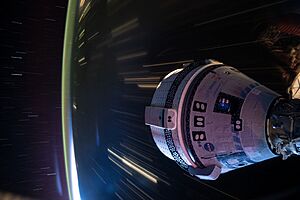
On 14 June, after their undocking date was pushed back to 22 June, the CFT astronauts had a call with Boeing mission managers to discuss the end of the mission and then entered Starliner to review the spacecraft's flight operations and procedures. On the weekend of 15 and 16 June, they performed tasks related to their CFT mission and assisted the ISS crew. On 17 June, Williams worked on maintenance tasks and prepared the Advanced Plant Habitat for future experiments, and on 18 June she continued working on the gene sequencing study from the prior week. Meanwhile, Wilmore spent the two days working on a study of the behavior of flowing liquids in space.
NASA said that since their arrival on 6 June, Wilmore and Williams have been tasked with completing half of all hands-on research time conducted aboard the ISS, giving their crewmates more time to prepare for the departure of Northrop Grumman's Cygnus NG-20 spacecraft.
While Starliner is docked to the ISS, NASA and Boeing teams have continued to assess the spacecraft's performance, especially relating to the helium leaks and RCS thruster problems. NASA delayed the end of the mission several times to continue testing the spacecraft in space; because the service module is discarded on reentry, NASA and Boeing will not have another opportunity to collect data from it. On a 10 June update, NASA reported a fifth small helium leak in the service module, plus a new problem: an RCS oxidizer isolation valve that did not close properly. On 15 June, the spacecraft was powered on for a test of the RCS thrusters, during which seven of eight aft-facing thrusters performed nominally, including four of the five that had malfunctioned during docking. One thruster, which could not be restored during docking, was deemed unusable and will not be used for the remainder of the mission. This test also enabled engineers to measure the helium leaks in the spacecraft, and all five leak rates were found to have decreased. The cause of the helium and thruster problems remained unknown. NASA managers speculated that the intense "dynamic operations" during the docking sequence could have contributed to the problems.
In July, a joint NASA-Boeing team began conducting ground tests at the White Sands Missile Range in New Mexico on an RCS thruster that was planned to be used on a future Starliner mission. The team simulated conditions that Calypso experienced from launch to docking with over 1,000 pulses, then simulating five undock-to-deorbit firing sequences with 500 pulses, including sequences with longer and more frequent pulses. These tests were completed by 18 July.
During these tests, the team was able to replicate the thrust degradation that caused the thrusters to fail. When the test thruster was disassembled, the team found that a Teflon seal had been deformed. A buildup of heat appears to have caused Teflon seals in the thruster to bulge and constrict the flow of propellant. However, when the tests were replicated on the Starliner in orbit, the same problem was not seen, and even thrusters which had previously lost significant thrust performed close to normal, suggesting that the seals might not be the root cause.
After those results, at a meeting of key NASA engineers called the Program Control Board, Ken Bowersox said, "We heard from a lot of folks that had concerns." The meeting ended with no agreement on flight rationale for returning Wilmore and Williams to Earth on Starliner.
Boeing, for its part, expressed confidence in Starliner and the belief that there was flight rationale for returning the spacecraft to Earth with the astronauts aboard.
Amid the uncertainty, NASA delayed the launch of its SpaceX Crew-9 mission originally scheduled for 18 August to 24 September 2024. NASA said that it wants Starliner to be undocked from the ISS before the launch of Crew-9. The agency also considered several return scenarios if Starliner was deemed unsafe to bring Williams and Wilmore home, including launching Crew-9 with two empty seats. However, NASA said that taking such an action would add additional risks as the Starliner would require a software update to allow it to fly autonomously.
Unmanned return to earth
NASA's originally planned for Starliner to undock from the ISS and return to Earth on 14 June, concluding an eight-day stay. The landing was delayed several times by NASA and Boeing to investigate why the helium leaked and the maneuvering thrusters failed. On 28 June, NASA announced that Starliner would not be approved to fly until its thruster problems were solved, or at least better understood, or if if the ISS were to experience an emergency. NASA and Boeing initially said Starliner could remain docked to the ISS for up to 45 days, but later said that the performance of its batteries would permit a stay of up to 90 days.
On 24 August, NASA announced that the agency had decided it was too risky to return Wilmore and Williams to Earth aboard Starliner, and that the crew would instead return in 2025 on a Crew Dragon, joining members of the planned SpaceX Crew-9 mission. That mission will now launch with two astronauts on board instead of four, leaving two empty seats for Williams and Wilmore. Because ISS has only two IDSS ports, Starliner must undock before Crew-9 can dock. Because each crew member must have a "lifeboat" to use if the station suffers an emergency, SpaceX developed and NASA approved an emergency evacuation configuration of the Dragon spacecraft in which up to three crew members would strap themselves to the floor of the Dragon spacecraft, where cargo is normally stored, which would be covered with foam.
Starliner's problems and the consequent extension of the astronauts' stay received much media attention. Boeing objected to some reporters' description of the astronauts as being "stuck" in space. After NASA decided to end the Starliner test flight without a crew on board, the company refused to answer questions from journalists, instead opting to release only brief statements. Reporters argued that NASA and Boeing should have been more transparent about the mission.
Under Starliner's original plan, the trip home from ISS would have begun with the astronauts closing the hatch and about three hours of further preparation for undocking. Once undocked, the capsule would have performed a full spiral around the station, flying above, behind, and below the station before firing the thrusters to begin the trip back to the western United States, where the capsule would have landed about six and a half hours later.
Instead, when the uncrewed Starliner undocked on 6 September at 22:04 UTC, it executed a simpler, less mechanically stressful posigrade maneuver to back Starliner away from the ISS, mostly relying on firing the forward-facing thrusters, which experienced no problems during docking. The spacecraft then executed a deorbit burn at a safe distance away from the station.
Starliner reentered the atmosphere about six hours after undocking. It deployed three parachutes, slowing the capsule to about 4 miles per hour (350 ft/min; 1.8 m/s). Before reaching the ground, six airbags deployed to cushion the landing. It landed in the White Sands Missile Range in New Mexico on 7 September at 04:01:35 UTC (6 September, 11:01:35 pm MDT, local time at the landing site), All potential landing sites were in the western United States, allowing the service module to be jettisoned for a destructive reentry over the Pacific Ocean.
During the reentry, Starliner experienced two technical problems unrelated to its earlier issues: a brief glitch in its navigation system, and a failure to ignite by one of the 12 thrusters used to orient the capsule during atmospheric re-entry. The thruster that failed is a monopropellant thruster mounted on the capsule and is separate from the bipropellant thruster system inside the service module that malfunctioned in orbit.
See also
 In Spanish: Boe-CFT para niños
In Spanish: Boe-CFT para niños
- Commercial Crew Development
- SpaceX Dragon 2
- Crew Dragon Demo-2, SpaceX's first crewed mission of their capsule




